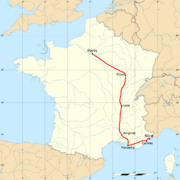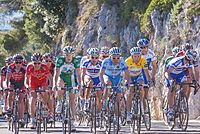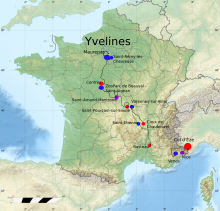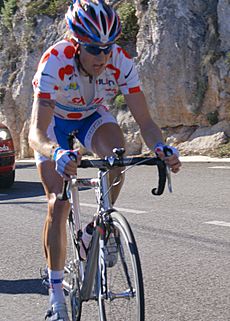Paris–Nice facts for kids
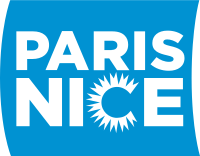 |
|
| Race details | |
|---|---|
| Date | March |
| Region | France |
| Nickname(s) | La course au soleil The Race to the Sun |
| Discipline | Road |
| Competition | UCI World Tour |
| Type | Major one week stage race |
| Organiser | Amaury Sport Organisation |
| Race director | Christian Prudhomme |
| History | |
| First edition | 1933 |
| Editions | 83 (as of 2025) |
| First winner | |
| Most wins | |
| Most recent | |
The Paris–Nice is a super exciting bike race that happens every year in France. It's a "stage race," which means it's not just one long ride, but several shorter races (stages) over about eight days. The race usually begins near Paris, where it might be cold, and finishes in the sunny city of Nice on the Mediterranean coast. That's why it's often called The Race to the Sun!
This race is a big deal in the world of cycling. It's part of the UCI World Tour, which is like the top league for bike racing. Many famous cyclists have won Paris–Nice, including Jacques Anquetil, Eddy Merckx, and Laurent Jalabert. The rider who has won it the most times is Sean Kelly from Ireland, who won it seven times in a row in the 1980s!
A very important rule in cycling came from this race. In 2003, a rider named Andrey Kivilev had a serious accident and sadly passed away. He wasn't wearing a helmet at the time. Because of this, the main cycling organization, UCI, made a rule that all riders must wear helmets during races. This rule helps keep cyclists much safer.
Contents
History of the Race to the Sun
How Paris–Nice Started
The Paris–Nice race began in 1933. A newspaper owner named Albert Lejeune created it to help promote his newspapers in Paris and Nice. The idea was to connect the French capital city with the beautiful seaside city of Nice. It was held in March, right after winter, making it one of the first big bike races of the year in France.
The first race had six stages and was called Les Six Jours de la Route (which means "Six Days of the Road"). The first stage was super long, about 312 kilometers! Since it was early in the year, the route avoided the big mountains like the Alps. The first winner was Alphonse Schepers from Belgium. He wore the leader's jersey from start to finish!
The race was very popular and happened every year until 1939. It stopped during World War II. After the war, it came back for a short time in 1946 but then stopped again until 1951.
The Race Gets Revived
In 1951, the mayor of Nice, Jean Medecin, brought the race back. He wanted to encourage more people to visit Nice and the Côte d'Azur. At first, it was called Paris-Côte d'Azur, but in 1954, it went back to being called Paris–Nice.
The race became more and more important in the 1950s. It wasn't just a practice race anymore; it was a major event. Famous riders like Louison Bobet and Jacques Anquetil started winning it. In 1957, a journalist named Jean Leulliot took over organizing the race.
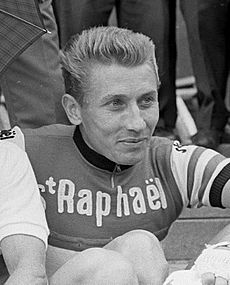
In 1959, they tried a super long race called Paris–Nice–Rome, but it was too long and didn't happen again. In 1966, there was an amazing rivalry between two French cycling legends, Jacques Anquetil and Raymond Poulidor. Anquetil won his fifth and final Paris–Nice that year.
In 1969, the final stage moved to the top of the Col d'Èze, a hill overlooking Nice. Young Eddy Merckx won the time trial there and started a streak of three wins in a row. Raymond Poulidor finally won in 1972 and 1973, beating Merckx!
In the 1980s, Sean Kelly from Ireland became the "King of Paris–Nice," winning it seven times in a row from 1981 to 1988. That's still the record today! Other great riders like Miguel Induráin and Laurent Jalabert also won in the 1990s. In 2002, the company ASO, which also organizes the Tour de France, took over the race.
Paris–Nice in the World Tour
The 2003 race was a sad one because of the accident involving Andrei Kivilev. His friend Alexander Vinokourov won a stage a few days later, holding a picture of Kivilev.
In 2005, Paris–Nice became part of the new UCI Pro Tour. There was a disagreement between cycling organizations in 2008, but it was sorted out. Since 2011, Paris–Nice has been the first big European stage race of the UCI World Tour season.
In 2012, Bradley Wiggins from England won the race. He was one of many riders who won Paris–Nice before also winning the Tour de France. More recently, riders like Alberto Contador and Richie Porte have won the race twice.
The 2020 Paris–Nice was one of the last big sports events in France before the global health situation caused many events to stop. The race was shortened, and German rider Max Schachmann won it.
The Race Route
The Paris–Nice race usually follows a similar path each year. It starts on a Sunday, often with a short time trial near Paris. Then, riders cycle south across France. The early stages are usually flat, which is good for fast sprinters. As the race moves south towards the Provence region, the stages become hillier and more challenging. These hilly stages are often where the race is decided.
The final stage on Sunday is either a regular road race ending on Nice's famous Promenade des Anglais or an uphill time trial on the Col d'Èze. The Col d'Èze is a climb that goes up to 507 meters high. Because riders need to be good at both time trials and climbing, Paris–Nice is often called a "mini-Tour de France."
Sometimes, the race route changes a bit. For example, the 2014 race didn't have any time trials or mountain-top finishes. But usually, it sticks to its traditional format.
Where the Race Starts
Until 1962, the race always started right in the city of Paris. But since 1963, it usually starts in smaller towns or suburbs near Paris. Sometimes, it even starts a bit further away. In 1982, the race started in Belgium, which was the only time it began outside France! The last time Paris–Nice started in Paris itself was in 2000.
Where the Race Finishes
Paris–Nice has always finished in Nice. For many years, it finished on the Quai des États-Unis or the famous Promenade des Anglais. From 1969 to 1995, the race often ended with a time trial up the Col d'Èze hill. This climb is about 9 kilometers long. Sean Kelly won the Col d'Èze time trial five times during his winning streak!
In 1996, the finish moved back to the Promenade des Anglais so more fans could watch. In recent years, the race often returns to a final time trial on the Col d'Èze. In 2012, Bradley Wiggins set a new record for climbing the Col d'Èze in just 19 minutes and 12 seconds!
In the 2025 Paris–Nice, Matteo Jorgenson had an amazing performance on the Col d'Èze. He left all his competitors behind while wearing the yellow jersey, which helped him win the whole race. The Col d'Èze is still a very important and challenging part of the "Race to the Sun."
Jersey Colours
Just like in other big bike races, the leaders in Paris–Nice wear special jerseys.
- Overall Leader: Since 2008, the rider leading the whole race wears a yellow jersey. This is similar to the famous yellow jersey in the Tour de France. In the past, the leader's jersey was blue and gold, green, or white.
- Points Leader: The rider who earns the most points (usually by finishing well in stages) wears a green jersey since 2008.
- King of the Mountains: The best climber wears a white jersey with red polka dots. This is also like the Tour de France! This jersey has changed colors many times over the years.
- Best Young Rider: This jersey is for the best rider under a certain age. It has been white since 2007.
Winners of Paris–Nice
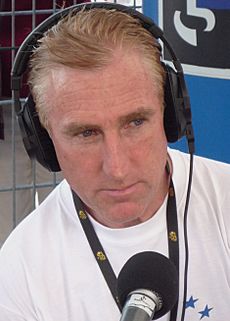
Here are some of the amazing riders who have won the Paris–Nice race:
| Rider | Team | |||
|---|---|---|---|---|
| 1933 | Alphonse Schepers | La Française | ||
| 1934 | Gaston Rebry | Alycon | ||
| 1935 | René Vietto | Helyett–Hutchinson | ||
| 1936 | Maurice Archambaud | Mercier–Hutchinson | ||
| 1937 | Roger Lapébie | Mercier–Hutchinson | ||
| 1938 | Jules Lowie | Pélissier-Mercier–Hutchinson | ||
| 1939 | Maurice Archambaud | Mercier–Hutchinson | ||
| 1946 | Fermo Camellini | Olmo | ||
| 1951 | Roger Decock | Bertin | ||
| 1952 | Louison Bobet | Stella-Huret | ||
| 1953 | Jean-Pierre Munch | Arliguie–Hutchinson | ||
| 1954 | Raymond Impanis | Mercier–BP–Hutchinson | ||
| 1955 | Jean Bobet | L. Bobet–BP–Hutchinson | ||
| 1956 | Fred De Bruyne | Mercier–BP–Hutchinson | ||
| 1957 | Jacques Anquetil | Helyett | ||
| 1958 | Fred De Bruyne | Carpano | ||
| 1959 | Jean Graczyck | Helyett | ||
| 1960 | Raymond Impanis | Faema | ||
| 1961 | Jacques Anquetil | Helyett–Fynsec | ||
| 1962 | Joseph Planckaert | Flandria–Faema | ||
| 1963 | Jacques Anquetil | St.Raphael–Gitane | ||
| 1964 | Jan Janssen | Pelforth–Sauvage | ||
| 1965 | Jacques Anquetil | Ford–Gitane | ||
| 1966 | Jacques Anquetil | Ford–Hutchinson | ||
| 1967 | Tom Simpson | Peugeot–BP–Michelin | ||
| 1968 | Rolf Wolfshohl | Bic | ||
| 1969 | Eddy Merckx | Faema | ||
| 1970 | Eddy Merckx | Faemino | ||
| 1971 | Eddy Merckx | Molteni | ||
| 1972 | Raymond Poulidor | Gan–Mercier–Hutchinson | ||
| 1973 | Raymond Poulidor | Gan–Mercier–Hutchinson | ||
| 1974 | Joop Zoetemelk | Gan–Mercier–Hutchinson | ||
| 1975 | Joop Zoetemelk | Gan–Mercier–Hutchinson | ||
| 1976 | Michel Laurent | Miko–de Gribaldy | ||
| 1977 | Freddy Maertens | Flandria–Faema | ||
| 1978 | Gerrie Knetemann | TI–Raleigh–McGregor | ||
| 1979 | Joop Zoetemelk | Miko–Mercier | ||
| 1980 | Gilbert Duclos-Lassalle | Peugeot–Esso–Michelin | ||
| 1981 | Stephen Roche | Peugeot–Esso–Michelin | ||
| 1982 | Sean Kelly | Sem–France Loire | ||
| 1983 | Sean Kelly | Sem–France Loire | ||
| 1984 | Sean Kelly | Skil–Sem–Reydel | ||
| 1985 | Sean Kelly | Skil–Sem–Reydel | ||
| 1986 | Sean Kelly | Kas–Mavic | ||
| 1987 | Sean Kelly | Kas | ||
| 1988 | Sean Kelly | Kas–Mavic | ||
| 1989 | Miguel Induráin | Reynolds | ||
| 1990 | Miguel Induráin | Banesto | ||
| 1991 | Tony Rominger | Toshiba | ||
| 1992 | Jean-François Bernard | Banesto | ||
| 1993 | Alex Zülle | ONCE | ||
| 1994 | Tony Rominger | Mapei–CLAS | ||
| 1995 | Laurent Jalabert | ONCE | ||
| 1996 | Laurent Jalabert | ONCE | ||
| 1997 | Laurent Jalabert | ONCE | ||
| 1998 | Frank Vandenbroucke | Mapei–Bricobi | ||
| 1999 | Michael Boogerd | Rabobank | ||
| 2000 | Andreas Klöden | Team Telekom | ||
| 2001 | Dario Frigo | Fassa Bortolo | ||
| 2002 | Alexandre Vinokourov | Team Telekom | ||
| 2003 | Alexandre Vinokourov | Team Telekom | ||
| 2004 | Jörg Jaksche | Team CSC | ||
| 2005 | Bobby Julich | Team CSC | ||
| 2006 | Floyd Landis | Phonak | ||
| 2007 | Alberto Contador | Discovery Channel | ||
| 2008 | Davide Rebellin | Gerolsteiner | ||
| 2009 | Luis León Sánchez | Caisse d'Epargne | ||
| 2010 | Alberto Contador | Astana | ||
| 2011 | Tony Martin | HTC–Highroad | ||
| 2012 | Bradley Wiggins | Team Sky | ||
| 2013 | Richie Porte | Team Sky | ||
| 2014 | Carlos Betancur | Ag2r–La Mondiale | ||
| 2015 | Richie Porte | Team Sky | ||
| 2016 | Geraint Thomas | Team Sky | ||
| 2017 | Sergio Henao | Team Sky | ||
| 2018 | Marc Soler | Movistar Team | ||
| 2019 | Egan Bernal | Team Sky | ||
| 2020 | Maximilian Schachmann | Bora–Hansgrohe | ||
| 2021 | Maximilian Schachmann | Bora–Hansgrohe | ||
| 2022 | Primož Roglič | Team Jumbo–Visma | ||
| 2023 | Tadej Pogačar | UAE Team Emirates | ||
| 2024 | Matteo Jorgenson | Visma–Lease a Bike | ||
| 2025 | Matteo Jorgenson | {{{team name-2025}}} |
Riders with Multiple Wins
Some riders have won Paris–Nice more than once:
| Wins | Rider | Editions |
|---|---|---|
| 7 | 1982, 1983, 1984, 1985, 1986, 1987, 1988 | |
| 5 | 1957, 1961, 1963, 1965, 1966 | |
| 3 | 1969, 1970, 1971 | |
| 1974, 1975, 1979 | ||
| 1995, 1996, 1997 | ||
| 2 | 1936, 1939 | |
| 1954, 1960 | ||
| 1956, 1958 | ||
| 1972, 1973 | ||
| 1989, 1990 | ||
| 1991, 1994 | ||
| 2002, 2003 | ||
| 2007, 2010 | ||
| 2013, 2015 | ||
| 2020, 2021 | ||
| 2024, 2025 |
Wins by Country
Here's how many times riders from different countries have won Paris–Nice:
| Wins | Country |
|---|---|
| 21 | |
| 14 | |
| 8 | |
| 6 | |
| 4 | |
| 3 | |
| 2 |
Fun Facts About Paris–Nice
- The youngest rider to win Paris–Nice was René Vietto in 1935. He was only 21 years old!
- The oldest winner was Raymond Poulidor in 1973, who was 37.
- France has the most wins as a country, but no French rider has won since Laurent Jalabert in 1997.
- Many Paris–Nice winners have also won the Tour de France, which is the biggest bike race in the world! These include Louison Bobet, Jacques Anquetil, Eddy Merckx, Miguel Induráin, Bradley Wiggins, and Tadej Pogačar.
Fun Facts About Paris–Nice
- The youngest rider to win Paris–Nice was René Vietto in 1935. He was only 21 years old!
- The oldest winner was Raymond Poulidor in 1973, who was 37.
- France has the most wins as a country, but no French rider has won since Laurent Jalabert in 1997.
- Twelve winners of Paris–Nice have also won the famous Tour de France in their careers! This includes cycling legends like Jacques Anquetil, Eddy Merckx, and Miguel Induráin.
See also
 In Spanish: París-Niza para niños
In Spanish: París-Niza para niños


